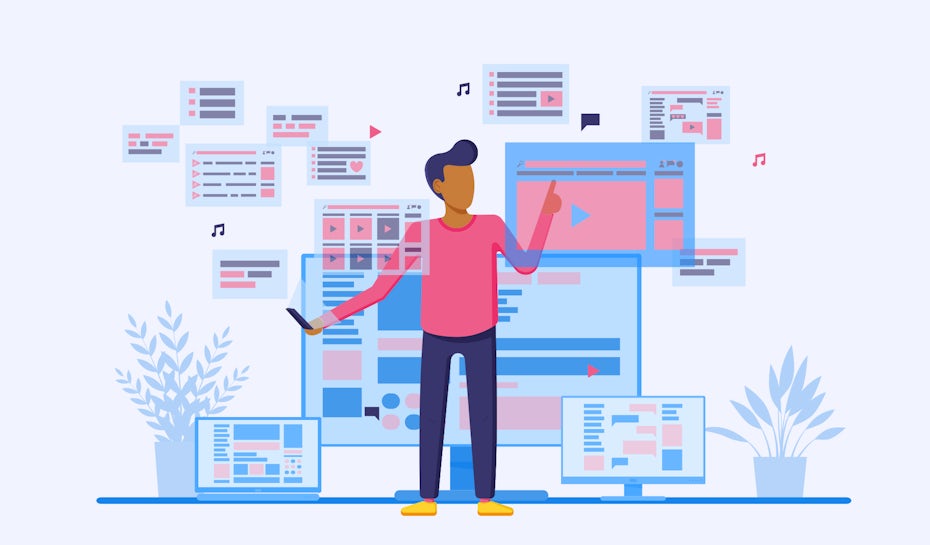Website design guidelines for clear navigation
Everything About Website Design: Understanding Its Importance for Your Online Existence
Internet design acts as an essential facet of establishing an on the internet presence. It affects individual experiences and shapes understandings of brands. Efficient internet style integrates numerous components that boost functionality and interaction. As the electronic landscape progresses, comprehending the relevance of these style principles comes to be necessary (website design). What are the crucial parts that make a website not just functional, however engaging? Discovering this could reveal crucial understandings for any individual aiming to be successful online
The Function of Website Design in Customer Experience
Internet layout exceptionally affects user experience by forming exactly how visitors connect with a website. Components such as layout, color pattern, and typography produce the very first impact, directing customers via the web content. Reliable internet style prioritizes intuitive navigation, making sure that visitors can conveniently locate info without irritation. Moreover, responsive design enhances availability throughout various devices, accommodating a wider audience. The rate of a web site also plays a critical function; slower-loading pages can cause greater bounce prices and decreased user satisfaction. Aesthetic hierarchy, achieved through spacing and size modifications, directs customers' attention to crucial attributes or calls to action. Consistency in design elements cultivates familiarity and trust, urging individuals to involve even more deeply. Ultimately, a well-designed site not just draws in site visitors yet also preserves them, affecting their overall assumption of the brand or service it stands for. This way, website design is a basic part of a successful online presence.
Secret Aspects of Efficient Internet Design
Effective website design rests on a number of essential aspects that boost individual engagement and fulfillment. Aesthetic power structure principles guide customers with web content, making certain that important details stands apart - branding. Mobile responsiveness is important in a digital landscape where individuals access sites throughout different devices.
Visual Power Structure Principles
Although many elements contribute to a successful site, the principles of visual pecking order stand apart as foundational to directing user experience. Aesthetic power structure refers to the setup of layout components to connect value and direct users' focus properly. Key aspects include dimension, spacing, shade, and comparison, which help prioritize details and create a circulation that is user-friendly for individuals. Larger components generally draw the eye first, while contrasting colors can highlight phone call to activity. Thoughtful spacing can also enhance readability and comprehension. By using these concepts, designers can craft a smooth experience that not just engages users but also facilitates navigation and improves general use. Ultimately, a well-executed aesthetic power structure boosts the site's efficiency in sharing its message.
Mobile Responsiveness Basics
Mobile responsiveness is a vital element of contemporary web design, making certain that websites operate effortlessly throughout numerous devices and screen dimensions. This flexibility enhances customer experience, as visitors can access content effortlessly whether they utilize a smart device, desktop computer, or tablet . Key aspects of mobile responsiveness consist of liquid grids, adaptable photos, and media questions, which allow layouts to adjust dynamically. Focusing on touch-friendly navigating and understandable typography better boosts use on smaller screens. In addition, enhancing loading rates is crucial, as mobile customers commonly expect quick access to info. By executing these basics, internet designers produce websites that involve customers, decrease bounce rates, and eventually add to increased conversions and customer complete satisfaction. Mobile responsiveness is thus vital for keeping a competitive on-line visibility.
The Impact of Website Design on Brand Assumption
Website design substantially affects brand assumption, beginning with the crucial impression a site makes on site visitors. Regular aesthetic components improve depend on and recognition, enhancing the brand's identification. In addition, a positive individual experience can form exactly how consumers involve and view with the brand name overall.
First Impacts Matter
Their first reaction can substantially influence their perception of the brand name when visitors run into a website. A properly designed website can evoke sensations of professionalism and trust, depend on, and integrity, while an inadequately built one might trigger suspicion and doubt. Customers typically develop judgments within secs, making the impression crucial. Aspects such as layout, color pattern, and typography play significant functions fit these first thoughts. For instance, a tidy and modern layout can communicate technology, whereas out-of-date visuals might recommend forget. Furthermore, an user-friendly navigating system boosts individual experience, enhancing positive perceptions. Consequently, reliable website design not just captures attention but also develops a strong structure for brand identity, influencing continuous relationships with visitors and potential clients.
Visual Consistency Constructs Trust

User Experience Influences Perception
A cohesive aesthetic identity lays the foundation for a positive customer experience, which substantially influences brand name understanding. Reliable internet design guarantees that users can navigate a website intuitively, leading to greater satisfaction and involvement. They are a lot more likely to associate the brand with professionalism and trust and reliability when customers come across a cosmetically pleasing and functional internet site. Alternatively, poor style can lead to irritation, triggering customers to form negative impressions. Components such as color design, typography, and design play a crucial function in shaping psychological actions. Ultimately, a properly designed site not just boosts use however also strengthens the brand's worths and message, developing a lasting effect on customer assumption and commitment. Consistency in layout further solidifies this link, fostering trust and familiarity.
Search Engine Optimization and Web Design
Effective website design is important for improving seo (SEO), as it directly influences just how search engines crawl and index a site. A well-structured site, featuring intuitive navigating and clear pecking orders, enables search engines to easily understand the web content and its importance. Furthermore, using optimized meta tags, headings, and alt text for images better help in enhancing exposure in internet search engine outcomes.
Page lots speed, a critical facet of internet design, significantly impacts SEO positions. Web sites that fill slowly may discourage individuals, bring about greater bounce rates, which online search engine take an unfavorable signal.
Including SEO ideal methods right into internet layout not only boosts online search engine positions but additionally ensures that site visitors have a Click Here positive experience. Eventually, a holistic technique to website design and search engine optimization can lead to raised traffic, much better user interaction, and boosted conversion prices, making it crucial for on the internet success.
Receptive Style: Meeting Individual Needs Throughout Tools
As individuals significantly gain access to internet sites from a variety of devices, receptive design has actually arised as an important solution for meeting their demands. This strategy assures that websites adapt perfectly to various display alignments, resolutions, and sizes, supplying an excellent watching experience. By employing fluid grids, adaptable pictures, and media questions, receptive style allows web content to scale and rearrange, enhancing functionality across mobile phones, tablet computers, and desktops.
Responsive style boosts site performance, as it usually decreases loading times via maximized photos and structured code. This performance not just improves individual fulfillment but likewise adds to much better online search engine rankings, as internet search engine favor mobile-friendly websites. As the electronic landscape remains to develop, organizations that prioritize receptive layout are better outfitted to engage their target markets efficiently, guaranteeing that users can connect and navigate with content no matter the device they use. As a result, responsive design is vital for preserving a strong online presence.
The Significance of Access in Internet Style
Web design not just needs responsiveness to different devices yet additionally demands a commitment to accessibility for all users. Availability in website design guarantees that individuals with impairments can browse, understand, and interact with on-line web content properly. This incorporates various elements, consisting of message readability, different message for pictures, and keyboard navigation options. By focusing on availability, web developers develop inclusive experiences that provide to a diverse target market, consequently widening their reach and boosting user complete satisfaction.
Accessible web sites can enhance search engine optimization and decrease prospective legal dangers linked with non-compliance to access standards. Businesses that welcome inclusive design not just fulfill honest commitments but likewise demonstrate social duty, cultivating a favorable brand image. Eventually, the value of accessibility in web style depends on its capacity to develop fair on-line environments, empowering all users, regardless of their abilities, to engage completely with digital material and solutions.
Patterns in Internet Layout: Staying Current in a Digital World
Staying abreast of trends in website design is important for makers intending to supply appealing and modern customer experiences. As modern technology develops, so do customer assumptions, making it vital for developers to incorporate contemporary aspects into their work. Present trends include minimalism, which prioritizes clean lines and enough white space, enhancing functionality and visual allure. Furthermore, the rise of dark setting options satisfies customer convenience while surfing.
Receptive layout continues to be essential, ensuring internet sites operate flawlessly across different tools. The integration of micro-interactions includes a layer of engagement, permitting individuals to feel a link with the website. Using vibrant typography and vivid color schemes can also aid catch attention in a crowded digital landscape. By welcoming these patterns, web designers can create aesthetically attractive, functional, and straightforward this websites, eventually reinforcing their customers' online presence and fostering positive individual interactions.
Often Asked Questions
Just How Much Does Expert Internet Design Usually Price?
Expert website design typically sets you back in between $2,500 and $10,000, depending upon intricacy and features. Personalized styles may boost costs additionally, while simpler themes can reduce costs, making pricing highly variable based on client requirements.

Can I Design My Internet Site Without Coding Knowledge?
Yes, a person can design a site without coding knowledge. Many user-friendly website contractors and content monitoring systems provide design templates and drag-and-drop features, making it possible for customers to produce visually appealing sites easily and efficiently.
What Prevail Errors to Avoid in Web Design?
Common blunders in internet design consist of messy designs, bad navigating, lack of mobile optimization, neglecting user experience, slow filling times, utilizing way too many fonts or colors, and neglecting accessibility. These mistakes can discourage visitors and lessen interaction.

Exactly how Usually Should I Update My Internet site's Layout?
A web site's design need to be updated every 2 to three years, or sooner if substantial fads emerge. Routine updates guarantee importance, boost user experience, and preserve compatibility with brand-new innovations and devices, cultivating recurring engagement.
What Tools Can Aid Me Develop My Own Site?
Numerous tools exist for producing internet sites, including WordPress, Wix, and Squarespace (website development). These platforms use user-friendly interfaces, personalized design templates, and different attributes that encourage people to develop web sites customized to their details needs and preferences
Web style greatly influences individual experience by forming just how site visitors interact with a web site. Reliable internet style pivots on several vital aspects that enhance customer involvement and fulfillment. Efficient internet style assurances that customers can navigate a web site without effort, leading to higher contentment and interaction. Staying abreast of trends in web design is vital for designers intending to supply appealing and modern customer experiences. Typical blunders in web layout consist of chaotic designs, poor navigation, lack of mobile optimization, disregarding individual experience, slow filling times, making use of also many font styles or shades, and ignoring accessibility.